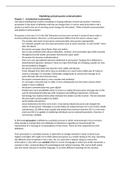Marketing and persuasive communication
Chapter 1 – Introduction to persuasion
Just about anything that involves moulding or shaping attitudes involves persuasion. Moreover,
persuasion is the study of attitudes and how we change them. It can be used by brands to sell a
product as well in the act of servicing social change (for the better). Think of health communication
and political communication.
Persuasion is not new; it is in the Old Testament and was even normal in ancient Greece when it
involved selling products. However, current persuasion differs from the past in various ways:
- The number and reach of persuasive communications have grown exponentially
For example, people now also wear persuasion such as actors wearing “Je suis Charlie” shirts
after the attack
- Persuasive messages travel faster than ever before
Due to ads combined with cultural celebrities, symbols, and commodity signs (Nike swoosh)
throughout (social) media, persuasion has become super quick
- Persuasion has become institutionalized
There are now specialized businesses dedicated to persuasion. Ranging from lobbyists to
advertisement agencies. However, there are signs that things are changing, people are now
also persuaded by bloggers
- Persuasive communication has become more subtle and devious
It has changed from hard-sell or play on emotions to a much more subtle way of trying to
convey a message. For example, McDonalds’ playgrounds to convey the message of an
active lifestyle with the fast-food chain.
- Persuasive communication is more complex and mediated
It’s no longer a focused task, it rather is more widespread over the entire society which
makes it more mediated
- Persuasive communication has gone digital
People have more possibilities when it comes to making the persuasive message due to the
current technological landscape with computers and editing programmes. Moreover,
technology has enabled interactivity between the sender and the receiver. The line between
the persuader and persuadee has faded
- Social media intersections
social media blurs the lines even more; it has democratized discourse and changed the
colours of persuasion. Messages on social media are unique because (1) it can involve simple
catchphrases; (2) diffuse more quickly and widely than previous channels (3) it is a two-way
street and (4) it is capable of mobilizing individuals across national boundaries. However, it
can become a bubble
In this book persuasion is defined as a symbolic process in which communicators try to convince
other people to change their own attitudes or behaviours regarding an issue through the
transmission of a message in an atmosphere of free choice. There are five components to this
definition.
First, persuasion is a symbolic process. It takes time to change someone’s mind, it doesn’t just
happen overnight. We ought not to think about persuasion as a vendor boxing in the ring, slamming
the different view of opinion in one’s face. No, it is more like a teacher trying to convey the
information. It also often uses symbols which is a form of language in which one entity represents a
concept or idea, communicating rich psychological and cultural meaning. This can be both verbal,
and non-verbal. Because it involves language, it can have different meanings for the receiver.
,Second, persuasion involves an attempt to influence. Remember that persuasion does not always
have the wanted effect. Therefore, we must make the distinction between people who actually want
to make a behaviour change in the other person and people who are merely discussing. Plus, the
person wanting to pursue must be aware that the other person is suspectable to having his mind
changed.
Third, people persuade themselves. After all, in order to convince others, we must first convince
ourselves of the thing we want to convince others. Changing our own beliefs first can be beneficial
when the time comes that we must change others’ opinions.
Fourth, persuasion involves the transmission of a message. It can take multiple forms or channels,
but it must involve some sort of message because it is a communicative activity. Note that books,
however, aren’t necessarily pure examples of persuasion. Journalists aren’t set out to make people
change their minds or behaviours about a certain topic, they just want to inform. Even though you
might not expect it, songs might change people’s objectives more than traditional channels of
communication. Although again not intentionally.
Fifth, persuasion requires free choice. In order to persuade someone, one must be able to let the
other person be persuaded in his or her way and his or her time. This involves freewill to change a
mind, which means that one can do other than what is asked of him or her.
Now we need to make a distinction between persuasion and coercion (propaganda). Persuasion
deals with reason and verbal appeals. The definition for coercion is a technique for forcing people to
act as the coercer wants them to act– presumably contrary to their preferences. We must remember
that the two are not polar opposite but rather two overlapping concepts.
Coercion occurs when the influence agent: (a) delivers a
believable threat of significant physical or emotional harm to
those who refuse the directive, (b) deprives the individual of
some measure of freedom or autonomy, and (c) attempts to
induce the individual to act contrary to her preferences.
Propaganda is defined as a form of communication in which the
leaders of a ruling group have near or total control over the
transmission of information, typically relying on mass or social
media to reach target audience members, using language and
symbols in a deceptive and manipulative fashion. There are some
key differences between propaganda and persuasion:
1. Propaganda refers to instances in which a group has near or total control over the transmission
of information and dissent is prohibited or forcibly discouraged
2. Propaganda is deceptive, presenting only one sliver of the facts. Propagandists deliberately hide
facts
3. Propaganda typically involves the media, either mass media, or interactive media
4. The difference between the connotation or meaning of terms. Propaganda has become known to
be something very negative
However, note that there is a difference between manipulation and propaganda, even though they
overlap. The definition for manipulation is a persuasion technique that occurs when a communicator
hides his or her persuasive goals, hoping to mislead the recipient by delivering an overt message that
disguises its true intent. Persuaders are therefore not manipulators, they’re transparent in their motives.
,There are said to be three different persuasive effects:
- Shaping
E.g. making a symbol be associated with a cause or brand or certain social values and attitudes
- Reinforcing
E.g. making people hold the to the certain believes or attitudes one already has
- Changing
E.g. conveying people to support gay marriage
Chapter 2 – Historical and ethical foundations
This chapter will give an overview of where persuasion stems from. Starting in Ancient Greece with
rhetoric which refers to the use of argumentation, language, and public address to influence audiences.
The Greeks loved this public speaking and even awarded awards for the best. There were even teachers
in this activity called ‘sophists’.
Aristotle was the first to make long-lasting contributions to rhetoric by three main ingredients: ethos
(speaking to the nature of the communicator), logos (speaking to one’s logic), and pathos (speaking to
one’s feelings). Throughout history we see signs of rhetoric in mass public speaking or as an emotional
appeal (WWI). Although we now see a more scientific approach.
The social scientific approach stems from 1930s when scientists were obsessed with ‘attitude’. Hovland
analysed the tape Why we fight. He saw that a credible source is greatly important of trying to persuade
someone. He was the first to combine Aristotle into the mix. We saw a split in social sciences with a
distinction between marketing and communication scholars. The communication from a company is now
way more pre-researched.
Some ‘theories’ about persuasion:
- Advertising exploits people (problem with exploit being negative)
- You can't persuade people by scaring them (problem because scaring into stop using drugs is
good)
- The key to being persuasive is physical appeal (problem because appeal might make one jealous)
Some other statements on persuasion:
- Persuasion, by contrast, is a profoundly civilizing influence
- Persuasion is not always pretty
- Persuasion is not analogous to truth
- Persuasion assumes without question that people have free choice—that they can do other
than what the persuader suggests
You can question whether persuasion is ethical. Therefore you should be aware that it involves a lot of
consideration and respect. The three viewpoints:
1. The attainment of goals—money, prestige, love, or religious fulfilment—requires that we
influence others in some fashion somewhere along the way
2. Kant saw it as immoral because people were being used as means if they’re being persuaded
3. Persuasion can be used for a host of good or bad purposes, with ethical and unethical
intentions
There are two approaches under normative theories of ethics; utilitarianism and
deontology. Utilitarianism offers a series of common-sense solutions to moral
dilemmas. It also contains an elaborate set of postulates that can help people to
decide whether particular actions are morally justified. Deontological thought was
formed by Kant and argues that the moral value of an act derives not from the
consequence it produces, but in the intention from which the act is performed. It is
summarized in the box. Present day we think differently about this.
, Lecture 1
Persuasive communication is much broader than marketing communication, however, it is the
foundation of most marketing communication. After all, if you want to sell laundry detergent, you
must appeal to the public in order to get them to buy yours.
Social marketing communication is marketing for a ‘good’ cause. Which is opposed to
commercial/economical marketing communication that strives to persuade people into buying a
certain product.
The application areas of persuasion:
- Corporate sphere (marcom, sales, motivating, online campaigns)
- Public sphere (health com, political social debates)
- Individual sphere (relations, education, family life)
On average there is a stereotype that we think good-looking people are also more intelligent even
though beforehand we think differently. This shows the difference between thinking and measuring
stereotypes. Pretty people getting attributed with more benefits is called the halo effect.
Survey questions in ads don’t work because people don’t know what they want until we test the
effect with an experiment.
Chapter 3 – Attitudes: definition and structure
Attitude is a psychological construct that inheres or characterizes a person. Attitude is defined as a
learned, global evaluation of an object (person, place, or issue) that influences thought and action. It
has different characteristics. The first being, attitudes are learned, acquired over time. People used
to believe that it was entirely made up through nature. However, one can have a predisposition for
liking pineapple but if there is no pineapple one cannot like pineapple.
Second, attitudes are categorizations. Once someone has an attitude towards something he or she is
no longer neutral around the topic. To form such an attitude is a complex thing that involves time
and outside influences.
Third, attitudes influence thought and action. Because we have categorized things in our social
world, we will now act upon those matters with the attitudes we have formed. Practice what you
preach. Some are strong and constant while others are less strong and more flexible.
A close-lying concept are values which are ideals, guiding principles in one’s life, or overarching goals
that people strive to obtain. They can be seen as the desirable end-state or behaviours that
transcend specific situations.
Another close-lying concept are beliefs, however, this is more
cognitive than values or attitudes. Beliefs and facts are often
wrongfully mixed-up. There are descriptive beliefs which are
perceptions or hypotheses about the world that people carry around
in their heads. And there are prescriptive beliefs which are “ought” or
“should” statements that express conceptions of preferred end-
states.
There are different approaches to the structures of attitudes. First, the
expectancy-value approach which asserts that attitudes have two
components: cognition and affect (head and heart). It is a combination of






